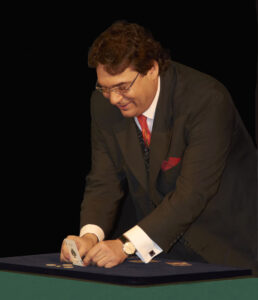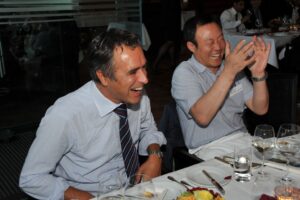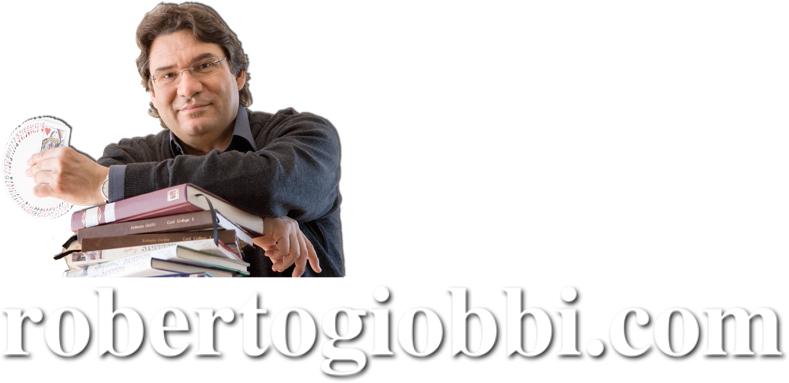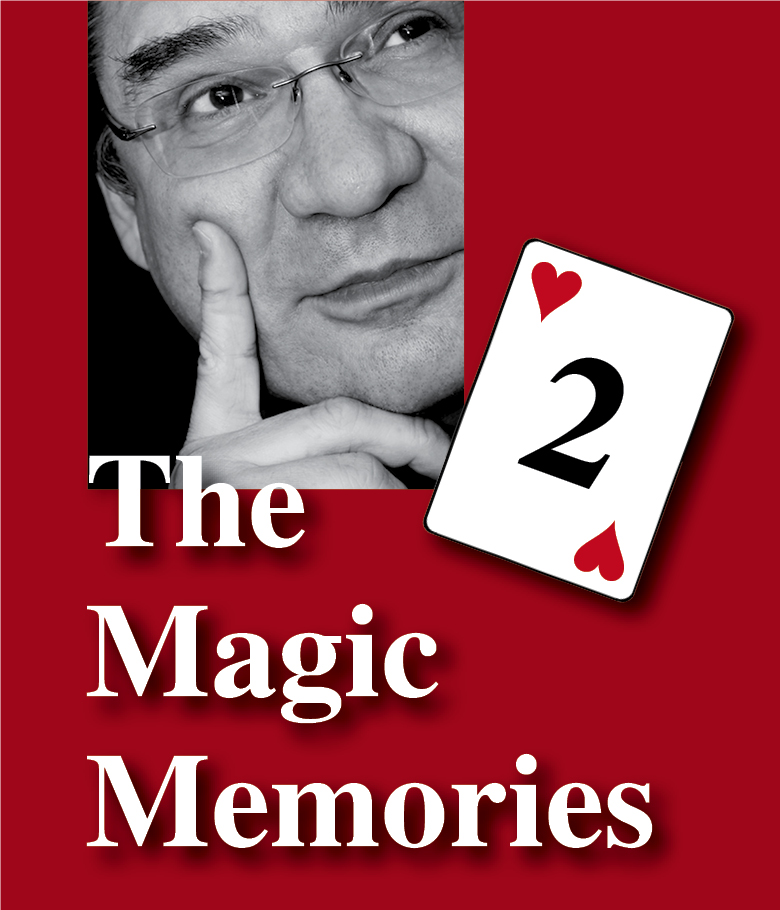
Hello everyone!
Today’s topics are: Addenda to “Applause Card”; Addenda to PATEO; Comments on Don Alan’s Professional Advice; The missing link (“The Ross Sisters”).
These are The Magic Memories 140, gone online Sunday, September 3rd, 2023, at 0:07h sharp.
All The Magic Memories from 2021, 2022, including the Magic Advent Calendar from 2020, can be found HERE.
Addenda to “Applause Card”
Mario Bove, from Brescia, Italy – the “Italian Card Expert” – wrote in and commented on last week’s post, specifically on one of the ten ways of revealing a chosen card I discussed, “Applause Card”, which I attributed to Dutch magician Marconick (see HERE).
Bove points out that Gerald Kosky had published precisely this same effect titled “Applause Card Disclosure” in Genii, vol. 29, no. 5, January 1965, p. 266. Thank you, Mario!
If you care to have a look at my short essay “Monkey Scale” in Sharing Secrets (p. 78), you might agree that the idea is not so high on that monkey scale, so, it is very well possible that the idea occurred to Kosky and Marconick independently. Especially if you consider the fact that neither one invented the effect of a card turning over apparently by itself on top of the deck (they came up with a method and presentation), but that this effect dates back even longer than Marlos’ “Acrobatic Card”, which was my first association, and the method – a folding card – is already described in Tricks With Cards by Professor Hoffmann in 1889.
Anyway, it’s a neat trick 🙂

Addenda to PATEO
Last week’s brief discussion of Roy Baker’s PATEO Force brought in several comments, and I’m glad so many seemed to like it – if you missed it, look it up HERE as the multi-layer technical construction of the trick makes for a really deceptive use of an otherwise not-so-strong principle.
My good friend Kéli Quertinmont from Nanterre, France, wrote in to say:
Regarding the PATEO force, thanks for sharing Roy Baker’s routine.My preferred routine with this principle can be found in Michael WEBER’s book LIFESAVERS, p. 75, “The Laying-on of Hands”.
Weber has some clever psychological twists – a brilliant mind already at a young age – but above all a lovely way of meaningfully stage the elimination process, by saying that you will now use a similar process as when two brothers have to share a piece of pie: One cuts the pie, the other selects which piece to take. The book, however, is out of print and expensive to get, but you can find it on bookfinder.com.
In his message Kéli also included a link to a TV magic show in Norway where you can see a very young Michael Weber (he’s not using PATEO here, but the Magician’s Choice) and Max Maven 🙂 Although the host speaks Norwegian, Weber and Maven perform in English for your enjoyment – click HERE.
Comments on Don Alan’s Professional Advice
Today’s The Magic Memories are inspired by the last chapter in Jon Racherbaumer’s book about the life and magic of Don Alan, In a Class by Himself – The Legacy of Don Alan , L&L Publishing, USA 2000. It is still available, e.g., from Penguin Magic. When I went to Penguin’s homepage, I noticed the book has one single review by a customer (at least it was a five-star review). It deeply saddens me to see that some crap tricks (please forgive the expression), some of which even make it to being nominated “Trick of the Year”, get dozens of positive reviews, whereas a brilliant book like this one lead a miserable existence. Help!
When reading Alan’s advice please remember that he had his heyday in the Fifties, Sixties and Seventies of the past century. Still, he touches on questions that are as valid today as they were half a century ago – my comments try to take this into consideration.
SNEAKY THINGS TO REMEMBER
1. List all the steps of a trick’s method, then underline and itemize every boring and banal action from a spectator’s point of view.
RG: Write a script, in two columns, what you do and what you say, and apply Alan’s advice to both columns, because what you say can be equally unneccessary and boring as what you do. It all boils down to the advice Jay Marshall used to give to almost everyone who asked, “Cut, cut, cut!”
2. All tricks must play to women.
RG: This advice comes from Alan’s experience from more than fifty years ago. Many things have changed how women perceive themselves and are perceived. From my personal experience I can say that women have been my best and my worst auciences.
The way an individual reacts, be it a man or a woman or any combination of it, depends largely on the situation the individual finds him- or herself, and also on the company. I always make it a point in my professional bookings to ask about the context of the event (is it a cultural, a private, or a business event), the type of audience (age, social status, language etc.)
In his Genii-column “The Vernon Touch” Dai Vernon even said several times that women don’t like card tricks. However, this is only true if it doesn’t have an emotional appeal, and this applies regardless of what the Instrument is used.
3. Write out all your utterances (patter) that goes along with the action steps. When it is possible and relevant, convert declarative und descriptive statements into questions. In particularly dull parts, interject short Jokes or amusing lines.
RG: See point 1). Generally speaking, tricks with lots of procedural handling should be eliminated. There are exceptions, e.g., when you are performing for felllow magicians, or for a group with specific interests, such as card players etc.
If procedures are necessary, such as dealing five hands of Poker, practice to deal swiftly, pause for a moment after having dealt the first round, look up, make an amusing remark; fascinate the audience at all times with content appealing to them ly. intellectually or emotionally.
4. Figure out where and how you can humanly interact with spectators during an effect. The most interesting aspect of any presentation usually concerns the audience. They are the “show.”
RG: A performance is about creating an act of communication between the artist and the audience, by means of the artist’s instruments and his discipline. In our case, as the performers of wonder, acting in a live situation, we must at all time be able to connect with our audience, and to keep
5. Determine how many spectators you want to involve in each presentation, then connect the dots in terms of interacting with them, playing off of them, and playing them off each other.
RG: Make sure that if you ask spectators to help they really get something meaningful to do. Avoid patronizing them, e.g., saying, “Oh, you did that very well.” That is how you talk to a five-year-old child, not an adult. Interacting with audience members is much easier when performing sitting down at the table, as Alan did, than if you perform in a parlor situation, where the spectator often needs to be brought up. The latter requires an additional set of skills.
6. Use a stop-watch to clock—time the duration of each presentation. If it runs longer than four minutes, figure out how to cut the “fat.” Make every second count.
RG: See 1.) I remember how Gene Anderson, in the pre-video aera, used to audio-tape his performances, and afterwards critically listening to them. Nowadays a good ploy is to ask someone to record your performance with a mobile phone. Both audio and video are also an excellent way of archiving your material, so you can go back to it years later.
7. Figure out which parts slow down a given trick, then figure out ways to eliminate this “drag.”
RG: Refer to 1.) Best strategy is to cut the “drag”, but if it is necessary for the trick to work, stage it properly, make it interesting and emotionally appealing.
8. List the number of unexpected moments or surprises. Every trick should have at least two surprises.
RG: See 9.)
9. List the number of magical moments where something puzzling or baffling occurs.
RG: This point and the preceding relate to 1.), i.e., use a variety of intellectual and emotional moments that keep the audience interested. However, make sure that dramatic unity is maintained, i.e., that those bits have something to do thematically with the main plot of the trick, and don’t use too many, as this would spoil the effect. Try to understand the essence of the trick, its effect, and then use only that many “extras” to enhance the effect, do not bury it under a heap of ketch-up (or mustard, or mayonnaise, or cheese, as is typically done in fast food “restaurants”).
10. Never perform two card-trick presentations in a row and never begin with a card trick.
RG: If two or three card tricks lead into each other in a coherent way and have dramatic unity, why not?
As for beginning with a card trick, and as exposed in my Stand-up Card Magic, I agree that almost all card tricks are conceptional rather than visual and should therefore be used after you’ve connected with the audinece and the ice is broken. However, there are a few things you can do with cards to open, such as “Six Card Repeat” for parlor, or “Micro-Macro”, a quick production of the Aces to lead into another visual Ace trick, such as “Twisting the Aces”, to then end with a strong Ace-piece, such as “Travelers”, or an “Ace Assembly”.
11. Use props that look ordinary or are recognizable as being common-place.
RG: Anything that looks as if it could be bought by anybody in a toy shop (Tenyo trick) should be avoided, unless you have a very good way of staging it. Generally, the quality and look of the instruments and props you are using, should match your “CI & CD”. However, there are exceptions here, too. I am sure Juan Tamariz has never spent a thought on this, and still he is one of the most successful pros on stage and in close-up. But: “Quod licet Jovi, non licet bovi.”
12. If the prop can be examined, leave it on the table after using it… as long as it is not in the way. Invite female spectators to hold, touch, and examine things. Engage male spectators to do anything that requires analysis and thinking—not because they do it better than females, but because it makes them feel relevant and important.
RG: If the prop left on the table entices them to handle it, make it part of the performance and allow enough time for it, but not as much as to break your planned timing. As Rubinstein said, “Virtuosity is when the musician masters his instrument, not vice-versa.” This is also true for mastering an audience.
13. Eliminate all hazards during the performance of a trick.
RG: Denis Behr once reminded me of a line I used in my first Penguin Live Lecture. “A professional does not take risks, he takes breaks.” That’s the idea.
14. Have two of everything.
RG: See The Magic Memories 69.
15. When it comes to Murphy’s Law, consider Murphy an optimist. Gimmick everything. (It is easier to force a corner—short card than to Classic Force a regular card.) It frees your thinking.
RG: Advice born out of hundreds (thousands?) of performances, and any working performer will agree… (However, since cards are my specialty, I’d stick to sleight-of-hands, unless the special card or deck really makes a big difference.)
16. When performing in a public place where other entertainers are also performing, go out of your way to speak to them. They are your allies.
RG: If you are performing as part of a larhger production, it is essential to coordinate your performance with the work of the others. Nowadays, in a professional surrounding, there is a person who manages all this. I always call the client several days before thumb show
17. Maintain momentum at all cost. Keep rolling. Don’t wait for laughter to completely die down. Begin your next presentation while the audience is still reacting to your last trick.
RG: There is a delicate balance between letting the audience react to an effect in the “Pause of Assimilation”, as Ascanio called it (Sharing Secrets, “Pause”, p. 82), and rushing to the next trick.
Even worse: Depending on the performing situation and the dynamics of an audience, this can be differ, even though you are performing exactly the same trick. Sensibility for communicative issues and a long performing experience are required.
If you lack this, because you are just starting out, you can compensate this with true enthusiasm and sincerity; do not be pretentious, and do not act like a smart aleck, and the audience will forgive (almost) everything.
18. Be spontaneous. When you can’t, fake it.
RG: … or as Groucho Marx used to say, “The secret of life is honesty and fair dealing. If you can fake that, you’ve got it made.”
A communication strategy I have found makes a stock line or one you have learned seem spontaneous, is to deliver it by looking at one single person, rather than saying it out into the audience. (This is not juts a “tip”, like some would have it, this is the expression of an attitude and leads into a much bigger subject.)
19. Use easy sleights, but figure out the best time to execute them. Never look at your hands during the execution and, if possible, ask a spectator a question at the crucial moment.
RG: It’s all there, just do it. One thing: The question asked needs to perfectly fit the context, otherwise it will be recognized as a ploy (see Sharing Secrets, “Clouding Question”, p. 30). You may think this is obvious, but I can assure you I have seen more than one performer who used a presentation and misdirective questions that had absolutely nothing to do with the theme of the trick…
20. If a deck is prearranged for certain tricks, always put a known keycard at the face (bottom). This “tips” that the deck is ready to go and is fully “wired.”
RG: Lennart Green gave me this dodge years ago, and I put it in Secret Agenda (see “December 15 – A Special-Deck Mnemonic”).
21. The ratio of laughter to bafflement should be 6 to 1.
RG: This is easy to misinterpret, but on closer examination makes perfect sense: Most very good tricks have one climax, and that’s the moment of “bafflement”, meaning the moment the audience experiences the emotion of wonder, astonishment. But on t he way to reach it, there might be several humorous situations that provoke laughter, obviously depending on your performance style.
In any case one should follow Dai Vernon’s advice, only to use comedy that arises from the situation, as opposed to extraneous lines put on top of the trick just to get one more laugh. Also, remember what Juan Tamariz says in his The Magic Rainbow (“Magic and Comedy”, pp. 414): “Laughter is very dangerous for magic, artistically speaking. The main reason is that it can reduce the magical impact of the effect by causing a steep drop in dramatic tension, which prevents the audience from feeling astonishment and a sensation of the impossible…”
22. Every trick must be able to be seen by at least 30 people.
RG: In the first two chapters of Stand-up Card Magic I go to great lengths to explain the importance of setting up the audience so that everyone can see well. The same considerations apply to formal close-up, which is what Alan is talking about here.
That’s all, folks!

The Missing Link
As a little amusing bonus I leave you with a bit of nostalgia with The Ross Sisters. Never heard of them? Well, you should be surprised and amused (watch until the end).
To watch the short video CLICK HERE.
Wish you all an excellent week!
Roberto Giobbi

